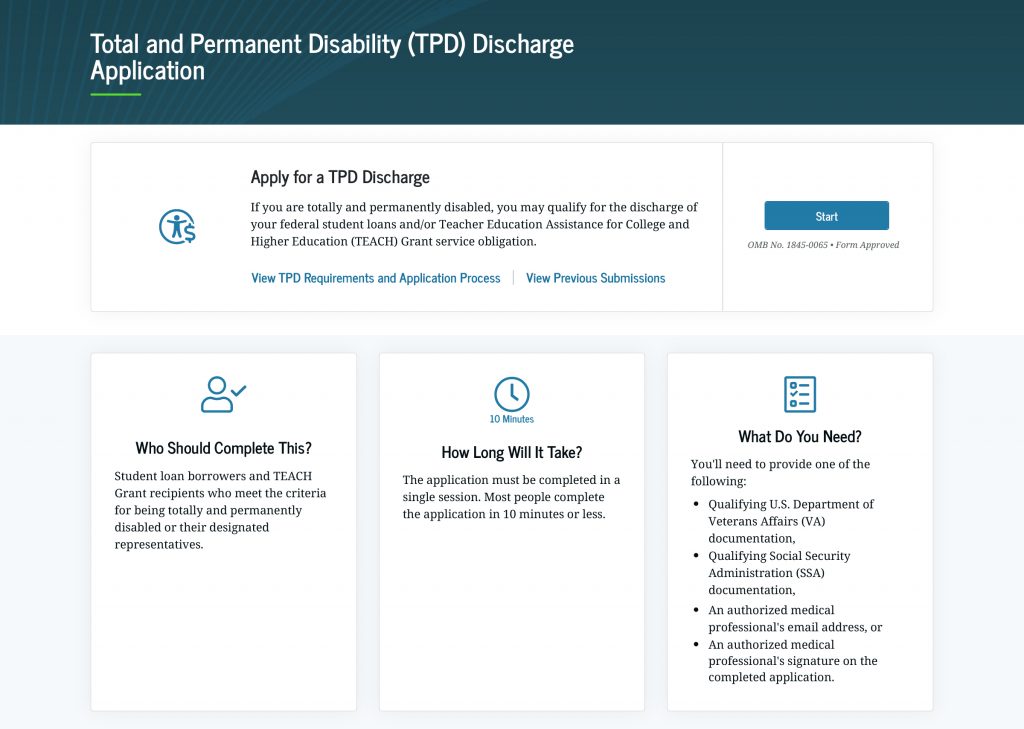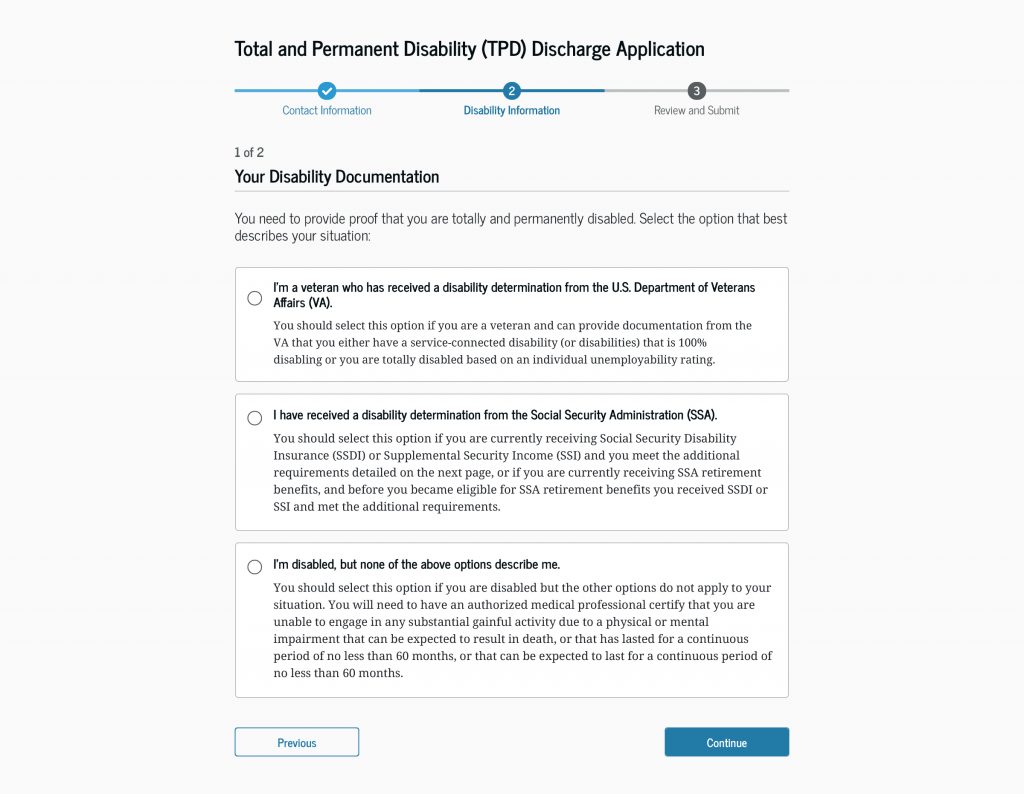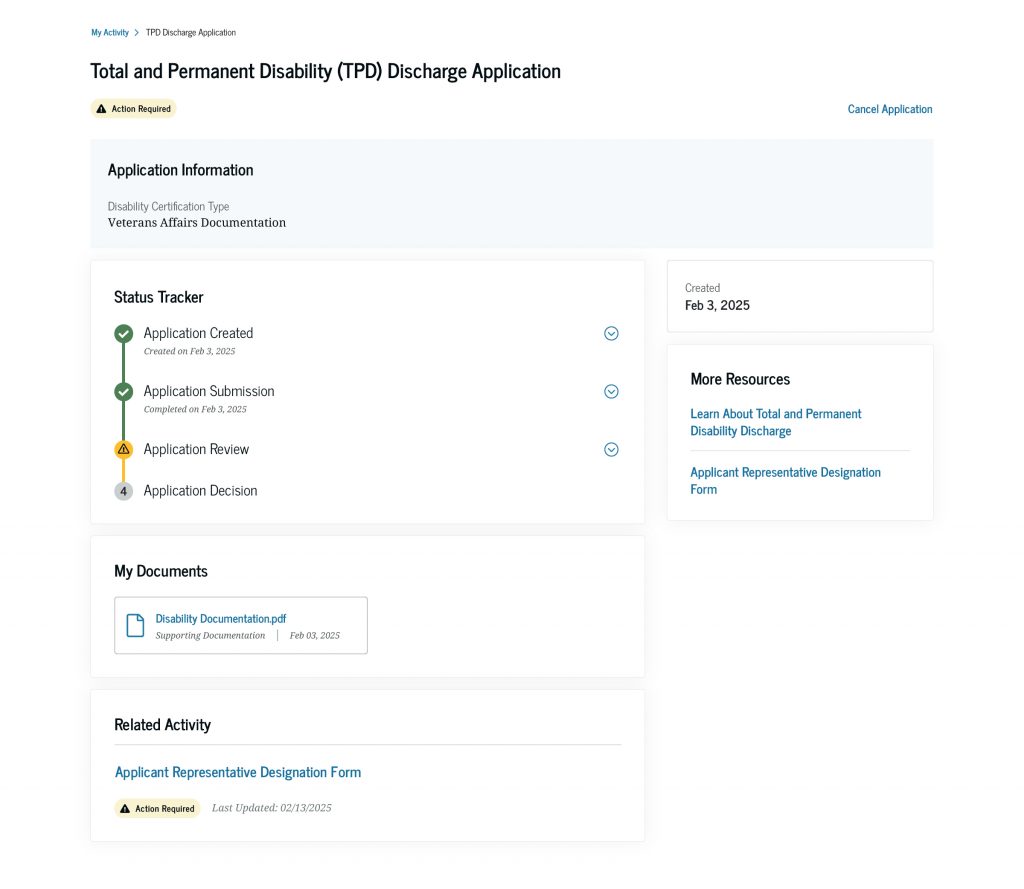How To Qualify and Apply for Total and Permanent Disability (TPD) Discharge

If you’re totally and permanently disabled, you may qualify for a discharge of your federal student loan(s) and/or Teacher Education Assistance for College and Higher Education (TEACH) Grant service obligation through total and permanent disability (TPD) discharge.
To receive TPD discharge, you must show that you have a physical and/or mental disability that severely limits your ability to work now and in the future. The application uses the term “an inability to engage in any substantial gainful activity.” In most cases, you’ll have to provide specific kinds of proof of your disability. There are three ways to qualify for TPD discharge through documentation or certification from one of these sources:
- The U.S. Department of Veterans Affairs (VA)
- The Social Security Administration (SSA)
- A medical professional
1
The U.S. Department of Veterans Affairs (VA)
You are eligible for TPD discharge if the VA awarded you a disability determination because you
- have a service-connected disability (or disabilities) that is 100% disabling , or
- are totally disabled based on an individual unemployability rating.
We work with the VA to identify people who qualify for TPD discharge, and we’ll send you a letter if you’re eligible.
Didn’t receive a letter? We work with the VA every quarter to identify people who qualify, so you may not receive a letter immediately after your determination. If you believe you have a qualifying VA disability determination, you can submit a TPD discharge application. When you apply for TPD discharge, you’ll need to provide documentation that shows when the VA awarded you the disability determination.
2
The Social Security Administration (SSA)
You can apply for TPD discharge if you’re eligible for Social Security Disability Insurance (SSDI) or Supplemental Security Income (SSI) benefits. For you to qualify this way, one of the following must be true:
- Your next continuing disability review has been scheduled within five to seven years from the date of your last SSA disability determination.
- Your next continuing disability review has been scheduled at three years.
- You have a medical onset date* for SSDI or SSI of at least five years before you apply for TPD discharge.
- You qualify for SSDI or SSI based on a compassionate allowance.
- You’re currently receiving SSA retirement benefits, and immediately before you qualified for retirement benefits, you met one of the requirements described in A–D above.
*Medical onset date refers to the official date your disability began. The SSA determines this date based on documentation in your case files.
Just because you receive SSDI or SSI benefits doesn’t mean you automatically get TPD discharge.
As we do with the VA, we work with the SSA to identify individuals who qualify for TPD discharge and will send you a letter if you’re eligible.
Didn’t receive a letter? If you believe you qualify based on an SSA disability determination, you can submit a TPD discharge application. You’ll need to provide either
- a copy of your SSA notice of award or
- your Benefits Planning Query.
3
A Medical Professional
Lastly, you can qualify for TPD discharge by getting a medical professional to certify the “Authorized Medical Professional Certification” section of your TPD discharge application. When you complete your application, you can choose certification via electronic signature and enter your medical professional’s email address. The medical professional will then receive an email from DocuSign (dse_NA4@docusign.net) with instructions to review and digitally certify your application.
But it can’t be just any medical professional—to certify your disability for TPD discharge, they must be licensed to practice in the United States. They must also be one of the following:
- Doctor of medicine (MD)
- Doctor of osteopathy/osteopathic medicine (DO)
- Nurse practitioner (NP)
- Physician’s assistant (PA)
- Certified psychologist at the independent practice level
To learn more about which medical professionals qualify to certify your application, visit the “Total and Permanent Disability Discharge” page.
The medical professional’s certification has to show a couple of things.
Firstly, it must show that you are “unable to engage in any substantial gainful activity.” This means that you can’t perform work for pay that involves doing significant physical or mental activities, or a combination of both.
Secondly, the medical professional must confirm that your inability to engage in substantial gainful activity is because of a physical or mental impairment (disability) that
- can be expected to result in death,
- has lasted for a continuous period of at least 5 years (60 months), or
- can be expected to last for a continuous period of at least 5 years (60 months).
How To Apply
If you believe you qualify for a TPD discharge but haven’t received an automatic discharge letter, you can submit a TPD discharge application digitally (which we recommend) or by printing a paper application.
To submit an application digitally, visit the TPD Discharge Application page. There, you can select “Start” to begin the application and will be directed to log in to your StudentAid.gov account.

You’ll be taken to the first section of the TPD discharge application where you’ll be asked to confirm your contact information. After confirming your information and selecting “Continue,” you’ll be taken to the next section: “Disability Information.” On the first page of this section, select the option that best describes your situation and disability then press “Continue.”

On the second page of the “Disability Information” section, you’ll need to follow the instructions to upload supporting documentation from either the VA or SSA of your eligibility for TPD discharge or provide your medical professional’s email address for them to certify your eligibility. In the final section of the TPD discharge application, you will agree to the terms and conditions to digitally sign your TPD discharge application.
We recommend completing, signing, and submitting your TPD discharge application online. If you’d prefer, you can print a prefilled TPD discharge application generated by the online application, manually sign it and have your authorized medical professional manually sign it (if applicable).
You can then upload your manually signed application in the “My Activity” section of your StudentAid.gov account. To do this, log in to StudentAid.gov and visit the “Document Upload Tool” page. From the dropdown below “Submission Type,” select “Total and Permanent Disability (TPD) Discharge.” Then, select either “TPD Application” or “Applicant Representative Designation Form” as appropriate for the form being uploaded. After selecting “Continue,” you can follow the instructions on screen to upload your completed and signed application and any required documentation.
If neither of these options work for you, you can download a blank TPD discharge application to fill out and submit manually. If you choose this option, you’ll need to mail your completed and signed application, along with any supporting documents, to this address:
U.S. Department of Education
P.O. Box 300010
Greenville, TX 75403
You can also fax your application and supporting documents to 540-212-2415.
A caregiver or representative can apply on your behalf if it’s a challenge to complete an application by yourself. They just need to complete an Applicant Representative Designation (ARD) form (also available as a downloadable PDF). The ARD form can also be uploaded through the “Document Upload Tool” (described above).
Once your application is submitted, you’ll be able to track its status in the “My Activity” section of your StudentAid.gov account. You can see the date your application was received and submitted, when your application is in the review stage, and when an application decision has been made.

For more information about TPD discharge—including eligibility, applications, and FAQs—check out our “Total and Permanent Disability Discharge” page.


